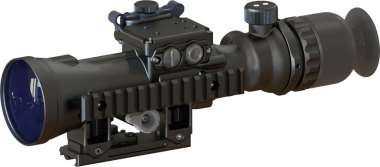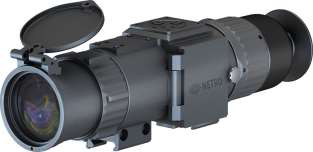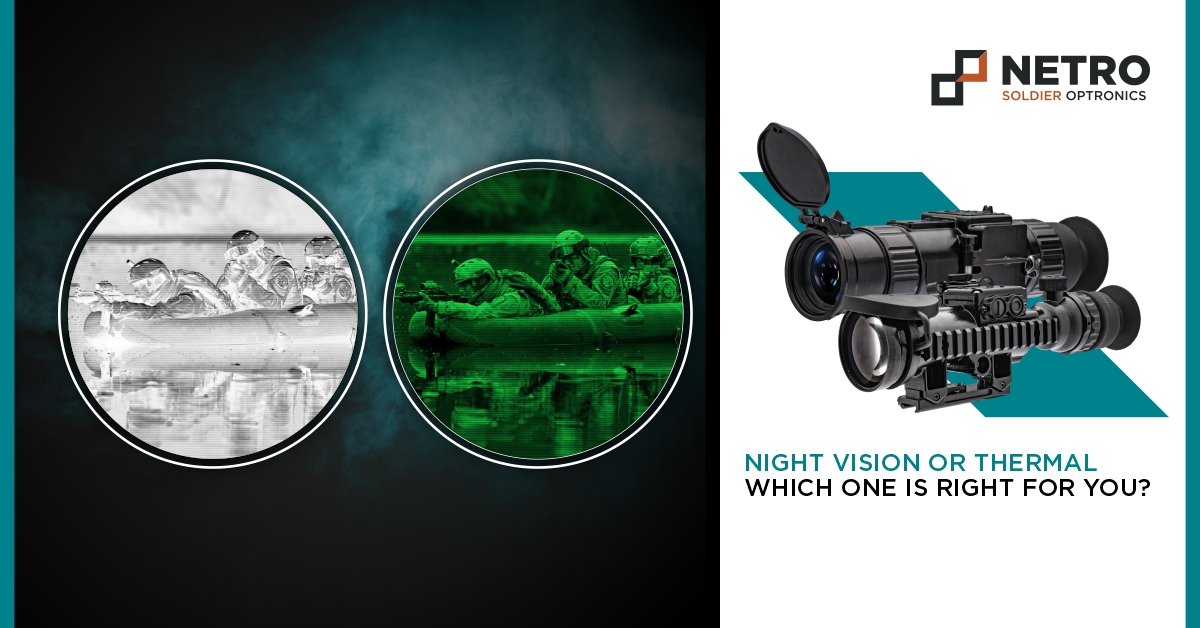To make an educated decision on choosing the best type of night vision weapon sight for use, let’s briefly understand how we as human beings, normally see at night without any help from special equipment. At the back of the human eye, on the retina, there are rod-shaped and cone-shaped receptors. While both help us sense light, rods help us see in dim light, but without colour, cones on the other hand allow us to see colour but don’t work very well in dim light. Night vision equipment works in a way that we are able to see more detail at night but without colour.
There are broadly 2 types of technologies at work for night vision weapon sights.
Image intensified (I2) Vs Thermal Weapon Sights

Image intensified weapon sights, also commonly referred to as II weapon sights or I2 night vision sights, intensify available light nearly 15,000 to 40,000 times to help us see at night. The available light could be moonlight, starlight or any other form of reflected light. The optics, electronics and sensors inI2 weapon sights have undergone tremendous advancements in recent years and offer excellent resolution and great functionalities. The latest Gen 3 and Gen 2+ sensor technologies offer excellent light intensification, frugal power consumption and great convenience for prolonged use.
I2 weapon sights need some ambient light to work (starlight, moonlight, reflected light etc), if there is no light then the I2 weapon sight does not ‘see’ very well.

Thermal weapon sights on the other hand work differently, they measure the difference in heat radiated by various objects in the surrounding areas to help identify targets. Thermal weapon sights use advanced optics, sensors to digitally processes the inputs from the optics of the device to deliver digital, raster images of the target and its surrounding. They can detect minutest temperature differences to deliver images in shades of grey.
Thermal weapon sights are not affected so much by light, they work solely on sensing heat radiations of the target and surroundings. If there is a temperature difference, thermal weapon sights will deliver good results. The amount of available light in this case does not matter, thus thermal sights can work effectively in day time also.
Considerations to keep in mind while choosing night vision weapon sights
Both technologies have certain strengths, and also limitations attached to them. The right choice for the type of device to choose for a specific application can be derived by understanding the above differences and some of the following considerations.
DRI (Detection, Recognition, Identification)
The major differences between the 2 types of weapon sights can be best understood through the concept of DRI, i.e. Detection, Recognition and Identification. Detection is achieved when a target is sighted as being there. Recognition is achieved then it is possible to recognize the shape and form of the target (i.e. animal, human, platform, etc). Identification is achieved then clear details of the target become visible.

I2 weapon sights offer excellent identification and offer near to the real images. They are best for situations where identification of the target is important like close-quarter battles (CQB) where it is important to distinguish between friend and foe. Thermal weapon sights on the other hand offer detection and recognition at much longer ranges and are ideally suited for situations when we want to monitor an acquired target's movement before tactical engagement. Thermal weapon sights do not offer identification even at closer distances.
Environment & Conditions
The major differences between the 2 types of weapon sights can be best understood through the concept of DRI, i.e. Detection, Recognition and Identification. Detection is achieved when a target is sighted as being there. Recognition is achieved then it is possible to recognize the shape and form of the target (i.e. animal, human, platform, etc). Identification is achieved then clear details of the target become visible.

sights are unable to see through glass and thus can be become ineffective when objects or targets are flanked by the glass.
Other parameters to consider
• Power consumption
I2 weapon sights are usually frugal in power consumption while thermal sights consume much more power
• IR Detection
I2 weapon sights have the capability to detect Infrared light which usually gives them an edge during tactical operations. Infrared rays are otherwise almost impossible to detect without the IR-sensitive optics of an I2 weapon sight. The addition of an IR illuminator/designator to an I2 weapon sight helps the I2 weapon sight to pick up the emitted infra-red light as a light source in very low light or pitch dark conditions to deliver a bright image to the operator thus giving him precise shot placement in difficult light conditions. This IR detection capability also allows the operators to recognise friends and foes when using IR beacons
Conclusion
There is no doubt that both I2 and thermal weapon sights deliver a big advantage and increase the capability of operators in low or failing light situations. Both of these technologies have performance characteristics that different users might prefer to use in different situations. While I2 sights deliver higher resolutions and target identification, it becomes difficult to locate targets which are stationary or camouflaged with I2 sights. It is in these situations that the thermal sights definitely provide a better solution as it becomes more difficult for the target to conceal a heat signature. While it is a fact that thermal sights cannot provide facial recognition with the way night vision does, these work independently of ambient lighting, and hence can be used both, in day time and night. Since both technologies fill the void of each other, it would be an ideal situation when both technologies are deployed or used together in units or platoons.


 LOGIN
LOGIN












